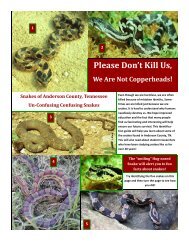Download as PDF - Great Smoky Mountains Institute at Tremont
Download as PDF - Great Smoky Mountains Institute at Tremont
Download as PDF - Great Smoky Mountains Institute at Tremont
You also want an ePaper? Increase the reach of your titles
YUMPU automatically turns print PDFs into web optimized ePapers that Google loves.
<strong>Gre<strong>at</strong></strong> <strong>Smoky</strong> <strong>Mountains</strong><br />
<strong>Institute</strong> <strong>at</strong> TRemont<br />
More Than Just a Field Trip...<br />
Connecting<br />
Students & N<strong>at</strong>ure<br />
Independent Evalu<strong>at</strong>ive Study Detailing How<br />
<strong>Gre<strong>at</strong></strong> <strong>Smoky</strong> <strong>Mountains</strong> <strong>Institute</strong> <strong>at</strong> <strong>Tremont</strong><br />
Programs Impact Students’ Attitudes<br />
About N<strong>at</strong>ure and Their Surroundings
2 W h a t is Tr e m o n t ?<br />
<strong>Gre<strong>at</strong></strong> <strong>Smoky</strong> <strong>Mountains</strong> <strong>Institute</strong> <strong>at</strong> <strong>Tremont</strong>...<br />
...is a residential environmental learning center loc<strong>at</strong>ed within the heart of<br />
<strong>Gre<strong>at</strong></strong> <strong>Smoky</strong> <strong>Mountains</strong> N<strong>at</strong>ional Park. We are a priv<strong>at</strong>e, non-profit organiz<strong>at</strong>ion<br />
th<strong>at</strong> works closely with the N<strong>at</strong>ional Park Service to provide educ<strong>at</strong>ional<br />
programs th<strong>at</strong> incre<strong>as</strong>e the awareness, appreci<strong>at</strong>ion, and understanding of the<br />
n<strong>at</strong>ural and cultural resources of the <strong>Gre<strong>at</strong></strong> <strong>Smoky</strong> <strong>Mountains</strong> and promotes<br />
stewardship of these resources.<br />
Groups of all ages visit <strong>Tremont</strong> to live<br />
and learn, using the n<strong>at</strong>ional park <strong>as</strong> an<br />
outdoor cl<strong>as</strong>sroom. <strong>Gre<strong>at</strong></strong> <strong>Smoky</strong> <strong>Mountains</strong><br />
<strong>Institute</strong> <strong>at</strong> <strong>Tremont</strong> h<strong>as</strong> something for<br />
everyone. Whether focusing on the park’s<br />
rich cultural history or unf<strong>at</strong>homable<br />
biological diversity; participants in<br />
<strong>Tremont</strong>’s programs, school trips, adult<br />
workshops, family camps, and youth camps<br />
leave with a gre<strong>at</strong>er sense of wonder, depth<br />
of knowledge, and appreci<strong>at</strong>ion of history<br />
and n<strong>at</strong>ural systems.<br />
Miles of trails and a half million acres<br />
of mountains and forests surround <strong>Tremont</strong>.<br />
In addition to these excellent n<strong>at</strong>ural<br />
resources, <strong>Tremont</strong> facilities include a<br />
dormitory, dining hall, cl<strong>as</strong>srooms, outdoor<br />
meeting shelters, and a bookstore.<br />
…connecting people and n<strong>at</strong>ure<br />
This project w<strong>as</strong> made possible by funding from the ALCOA Found<strong>at</strong>ion and in partnership<br />
with the N<strong>at</strong>ional Park Service.<br />
<strong>Gre<strong>at</strong></strong> <strong>Smoky</strong> <strong>Mountains</strong> <strong>Institute</strong> <strong>at</strong> <strong>Tremont</strong> | www.gsmit.org
O u r Mi s s i o n<br />
3<br />
Our Mission<br />
<strong>Gre<strong>at</strong></strong> <strong>Smoky</strong> <strong>Mountains</strong> <strong>Institute</strong> provides in-depth experiences through<br />
educ<strong>at</strong>ional programs designed to nurture appreci<strong>at</strong>ion of <strong>Gre<strong>at</strong></strong> <strong>Smoky</strong><br />
<strong>Mountains</strong> N<strong>at</strong>ional Park, celebr<strong>at</strong>e diversity, and foster stewardship.<br />
“I feel special here, being a part of life.”<br />
—Celia, age 9<br />
I like looking through my dirty clothes and remembering how I<br />
got them dirty <strong>at</strong> <strong>Tremont</strong>.<br />
—Grace Christian School student<br />
<strong>Gre<strong>at</strong></strong> <strong>Smoky</strong> <strong>Mountains</strong> <strong>Institute</strong> <strong>at</strong> <strong>Tremont</strong> | www.gsmit.org
4 O v e r v i e w<br />
Project Overview<br />
Those involved in environmental educ<strong>at</strong>ion (EE)—both educ<strong>at</strong>ors working<br />
in the field and cl<strong>as</strong>sroom teachers who involve their students in EE<br />
programs—know how valuable a residential EE experience can be. Inquiry<br />
b<strong>as</strong>ed, experiential learning h<strong>as</strong> a dram<strong>at</strong>ic impact on students—not just<br />
their knowledge of the environment and environmental issues, but also their<br />
<strong>at</strong>titudes towards and understanding of n<strong>at</strong>ure, and their own place in it.<br />
These positive benefits, while readily apparent, have historically been hard to<br />
quantify.<br />
Our goal in conducting this evalu<strong>at</strong>ion<br />
project is to me<strong>as</strong>ure our residential<br />
program’s influence on participants’<br />
environmental awareness, <strong>at</strong>titudes,<br />
and behaviors. This inform<strong>at</strong>ion helps<br />
number of students th<strong>at</strong> took our survey<br />
1,037during the ‘05/’06 and ‘06/’07 school years<br />
us improve our own programming, and<br />
supports teachers’ and administr<strong>at</strong>ors’<br />
involvement in residential or environmental<br />
educ<strong>at</strong>ion programs. This evalu<strong>at</strong>ion<br />
project also allows us to me<strong>as</strong>ure the value<br />
of a residential EE experience for school<br />
program participants, giving us scientific<br />
d<strong>at</strong>a to support the positive benefits we (and<br />
others) have observed for years.<br />
While many previous evalu<strong>at</strong>ion<br />
studies looked <strong>at</strong> programs for<br />
rel<strong>at</strong>ively brief periods of time—weeks<br />
or months—<strong>Tremont</strong>’s evalu<strong>at</strong>ion<br />
process is long-term and ongoing. In<br />
2005, <strong>Tremont</strong> staff began conducting the<br />
survey with nearly every school group<br />
<strong>at</strong>tending a <strong>Tremont</strong> program. A study of<br />
this magnitude—conducted over several<br />
school years, with students from all over<br />
the country and from a gre<strong>at</strong> diversity<br />
of socio-economic backgrounds—gives<br />
us an incredibly accur<strong>at</strong>e picture of the<br />
effectiveness of our programs. The study is<br />
continuing, with surveys administered to<br />
students during the ‘07/08 school<br />
year and beyond.<br />
A random sample of students<br />
from each school group w<strong>as</strong><br />
administered a survey immedi<strong>at</strong>ely<br />
upon arrival on campus. The same sample<br />
of students took another survey just before<br />
departing for home. We refer to these <strong>as</strong> the<br />
pre-trip and post-trip surveys.<br />
Our survey also followed students<br />
beyond their trip to <strong>Tremont</strong>, back to<br />
their home cl<strong>as</strong>sroom. Three months<br />
following the trip, students and teachers<br />
completed a third survey to examine how<br />
number of school groups whose students<br />
particip<strong>at</strong>ed in the study during the same period112<br />
their knowledge and <strong>at</strong>titudes may have<br />
changed in the intervening months. We will<br />
discuss the results of the pre- and post- trip<br />
surveys first, and examine the results of the<br />
3-month post-surveys on page 11.<br />
<strong>Gre<strong>at</strong></strong> <strong>Smoky</strong> <strong>Mountains</strong> <strong>Institute</strong> <strong>at</strong> <strong>Tremont</strong> | www.gsmit.org
O v e r v i e w o f In d e x e s St u d i e d<br />
5<br />
Indexes<br />
Me<strong>as</strong>uring specific outcomes is rel<strong>at</strong>ively e<strong>as</strong>y—<strong>as</strong>k a<br />
student the definition to a vocabulary word before and<br />
after a lesson, and see wh<strong>at</strong> they’ve learned. Trying to<br />
me<strong>as</strong>ure values such <strong>as</strong> “sense of place and connection<br />
with n<strong>at</strong>ure” is considerably harder.<br />
To address these difficulties, <strong>Tremont</strong> staff, in conjunction with<br />
<strong>Gre<strong>at</strong></strong> <strong>Smoky</strong> <strong>Mountains</strong> N<strong>at</strong>ional Park (GSMNP) represent<strong>at</strong>ives and<br />
a professional evalu<strong>at</strong>ion team, developed a system of “indexes.”<br />
Each index consists of a series of rel<strong>at</strong>ed questions, each designed to<br />
reveal a student’s changing <strong>at</strong>titudes towards certain concepts and<br />
ide<strong>as</strong>—concepts th<strong>at</strong> can’t be addressed in a single, simple question.<br />
Our indexes were developed to reflect and me<strong>as</strong>ure the core values<br />
of our mission st<strong>at</strong>ement, <strong>as</strong> well <strong>as</strong> to me<strong>as</strong>ure other important<br />
impacts of our program, such <strong>as</strong> interest in learning and discovery.<br />
The four me<strong>as</strong>ured indexes are:<br />
——Connection with N<strong>at</strong>ure<br />
——Environmental Stewardship<br />
——Interest in Learning and<br />
Discovery<br />
Percentages<br />
100<br />
80<br />
60<br />
Student Indexes for the 2006-2007 School Year<br />
——Knowledge and Awareness<br />
of GSMNP and Biological<br />
Diversity<br />
Before<br />
After<br />
Results<br />
Show...<br />
A significant<br />
incre<strong>as</strong>e in all of our<br />
me<strong>as</strong>ured indexes.<br />
Students<br />
leave <strong>Tremont</strong><br />
with an enhanced<br />
understanding of<br />
GSMNP, a heightened<br />
interest in learning,<br />
a deeper feeling<br />
of connection with<br />
n<strong>at</strong>ure, and a gre<strong>at</strong>er<br />
willingness to act <strong>as</strong><br />
good stewards of the<br />
environment.<br />
40<br />
Stewardship<br />
Connection<br />
with N<strong>at</strong>ure<br />
Awareness<br />
Discovery<br />
Indexes<br />
As shown above, our impacts were clear. Every index we<br />
me<strong>as</strong>ured showed st<strong>at</strong>istically significant gains* between the pre- and<br />
post-<strong>Tremont</strong> trip surveys. In the following pages, we’ll discuss the<br />
findings of each index separ<strong>at</strong>ely.<br />
*All findings in this<br />
document are found to be<br />
st<strong>at</strong>istically significant,<br />
defined <strong>at</strong> the standard<br />
level of p
6 A Cl o s e r Lo o k a t Sp e c i f i c In d e x e s<br />
Results<br />
Show...<br />
Students left<br />
<strong>Tremont</strong> with a better<br />
understanding of our<br />
place in n<strong>at</strong>ure, and<br />
a gre<strong>at</strong>er interest<br />
in particip<strong>at</strong>ing in<br />
outdoor (r<strong>at</strong>her than<br />
indoor) activities.<br />
Connection with N<strong>at</strong>ure<br />
Students leave <strong>Tremont</strong> feeling th<strong>at</strong> GSMNP is their<br />
second home—a welcoming, comforting, and familiar<br />
environment.<br />
Percentages<br />
Connection with N<strong>at</strong>ure for the 2006-2007 School Year<br />
100<br />
Before<br />
After<br />
80<br />
60<br />
Students felt more<br />
comfortable in the<br />
outdoors after the<br />
trip.<br />
40<br />
Humans are a part of<br />
n<strong>at</strong>ure, not separ<strong>at</strong>e from it.<br />
Indexes<br />
I'd r<strong>at</strong>her visit a n<strong>at</strong>ional<br />
park than see a movie.<br />
More students<br />
left the Smokies<br />
saying they would<br />
r<strong>at</strong>her visit a<br />
n<strong>at</strong>ional park than<br />
play video games.<br />
This index is<br />
designed to me<strong>as</strong>ure<br />
the student’s desire<br />
to return to the<br />
Smokies and their<br />
developing love<br />
of n<strong>at</strong>ure. It also<br />
me<strong>as</strong>ures the<br />
students’ curiosity<br />
about the park,<br />
biodiversity, and<br />
the environment.<br />
Since I came home from <strong>Tremont</strong> I have gone outside every<br />
day, and I used to stay inside. Thank you.<br />
—Courtney, McFadden School of Excellence, TN<br />
<strong>Gre<strong>at</strong></strong> <strong>Smoky</strong> <strong>Mountains</strong> <strong>Institute</strong> <strong>at</strong> <strong>Tremont</strong> | www.gsmit.org
A Cl o s e r Lo o k a t Sp e c i f i c In d e x e s<br />
7<br />
Environmental Stewardship<br />
Students’ <strong>at</strong>titudes and behaviors will reflect an<br />
understanding of human impacts on the environment.<br />
This index is<br />
designed to evalu<strong>at</strong>e<br />
how students’<br />
behaviors and<br />
<strong>at</strong>titudes have<br />
become more<br />
environmentally<br />
conscious.<br />
<strong>Tremont</strong>’s lessons<br />
and practices are<br />
designed to model<br />
environmentally<br />
responsible<br />
behavior and<br />
decisions th<strong>at</strong> can<br />
be incorpor<strong>at</strong>ed<br />
into a student’s<br />
daily life back<br />
home.<br />
Percentages<br />
100<br />
80<br />
60<br />
Your camp changed my daughter permanently. Thanks for an<br />
excellent program. Not only did she talk non-stop about <strong>Tremont</strong>, but<br />
she changed her way of life to be more environmentally conscious.<br />
Environmental Stewardship for the 2006-2007 School Year<br />
—Beth Sutton, parent of school program participant<br />
Before<br />
After<br />
Results<br />
Show...<br />
Students<br />
showed an overall<br />
improvement in<br />
their <strong>at</strong>titudes<br />
towards<br />
conserv<strong>at</strong>ion, and<br />
their willingness<br />
to exhibit<br />
environmentally<br />
friendly behavior.<br />
More students<br />
said they would like<br />
to someday volunteer<br />
in a n<strong>at</strong>ional park,<br />
and would try<br />
harder to conserve<br />
n<strong>at</strong>ural resources<br />
(food, w<strong>at</strong>er, and<br />
electricity).<br />
Students’<br />
<strong>at</strong>titudes towards<br />
conserv<strong>at</strong>ion<br />
remained very strong<br />
three months l<strong>at</strong>er.<br />
40<br />
I am careful not<br />
to w<strong>as</strong>te food.<br />
I am careful not<br />
to w<strong>as</strong>te w<strong>at</strong>er.<br />
I talk to my friends and family<br />
about the environment.<br />
Indexes<br />
<strong>Gre<strong>at</strong></strong> <strong>Smoky</strong> <strong>Mountains</strong> <strong>Institute</strong> <strong>at</strong> <strong>Tremont</strong> | www.gsmit.org
8 A Cl o s e r Lo o k a t Sp e c i f i c In d e x e s<br />
Results<br />
Show...<br />
Students’<br />
knowledge of<br />
GSMNP incre<strong>as</strong>ed<br />
significantly.<br />
Knowledge and Awareness of<br />
GSMNP and Biodiversity<br />
Students will develop an appreci<strong>at</strong>ion for and knowledge<br />
of GSMNP and n<strong>at</strong>ural, wild places.<br />
Students<br />
learned<br />
specifics<br />
about the<br />
park and its<br />
issues (more<br />
students were<br />
able to define<br />
an “exotic”<br />
species), <strong>as</strong><br />
well <strong>as</strong> broader<br />
concepts of<br />
the benefits of<br />
n<strong>at</strong>ional parks<br />
(recognizing<br />
th<strong>at</strong> parks help<br />
protect plants<br />
and animals and<br />
keep the air clean).<br />
You learn so much by actually being there, experiencing first<br />
hand wh<strong>at</strong> you’ve only read about in books.<br />
—Gabe Herrera, Oak Park River Forest High School Senior, IL<br />
100<br />
Knowledge and Awareness for the 2006-2007 School Year<br />
This index is<br />
designed to me<strong>as</strong>ure<br />
students’ understanding<br />
of the importance<br />
of biologically<br />
diverse ecosystems.<br />
Also me<strong>as</strong>ured<br />
is the student’s<br />
understanding of<br />
the cultural and<br />
n<strong>at</strong>ural history<br />
of the Southern<br />
Appalachians, and the<br />
importance of parks’<br />
roles <strong>as</strong> protectors of<br />
species, culture, and<br />
our n<strong>at</strong>ural resources.<br />
Before<br />
After<br />
Students retained<br />
their new knowledge<br />
three months l<strong>at</strong>er.<br />
Percentages<br />
80<br />
60<br />
40<br />
Many people once<br />
lived on the land<br />
th<strong>at</strong> is now GSMNP.<br />
Biological diversity refers to<br />
the variety of plants, animals,<br />
and other types of living things.<br />
Indexes<br />
N<strong>at</strong>ural places help<br />
keep the air clean.<br />
<strong>Gre<strong>at</strong></strong> <strong>Smoky</strong> <strong>Mountains</strong> <strong>Institute</strong> <strong>at</strong> <strong>Tremont</strong> | www.gsmit.org
A Cl o s e r Lo o k a t Sp e c i f i c In d e x e s<br />
9<br />
Interest in Learning and Discovery<br />
Students will develop an interest and p<strong>as</strong>sion for<br />
learning.<br />
This index is<br />
designed to explore<br />
the impact of outdoor<br />
experiences on students’<br />
interest in learning more<br />
about n<strong>at</strong>ure, exploring<br />
the outdoors, and<br />
visiting n<strong>at</strong>ural are<strong>as</strong>. It<br />
also explores students’<br />
interest in learning<br />
more about diversity in<br />
people—learning more<br />
about different cultures<br />
and ways of life.<br />
100<br />
I wish every teacher could see their students in learning situ<strong>at</strong>ions <strong>as</strong><br />
unique <strong>as</strong> <strong>Tremont</strong>. The labels of “troublemaker,” “unmotiv<strong>at</strong>ed,” and<br />
“underachiever” melt away in your outdoor cl<strong>as</strong>sroom.<br />
Interest in Learning and Discovery for the 2006-2007 School Year<br />
—Peggy Steffan, Immacul<strong>at</strong>e Conception High School, Memphis, TN<br />
Before<br />
Results<br />
Show...<br />
Students showed<br />
a gre<strong>at</strong>er interest in<br />
learning about a<br />
wide variety of<br />
topics.<br />
Students left<br />
<strong>Tremont</strong> wanting<br />
to know more<br />
about plants,<br />
animals, and the<br />
places they live.<br />
Students<br />
wanted to learn<br />
more about<br />
cultural history,<br />
both about<br />
different cultures<br />
and ways of life, and<br />
the history of their<br />
hometowns.<br />
After<br />
Percentages<br />
80<br />
60<br />
40<br />
Interest in learning about<br />
plants, animals, and the places they live.<br />
Interest in learning about different<br />
cultures or other ways of life.<br />
Indexes<br />
<strong>Gre<strong>at</strong></strong> <strong>Smoky</strong> <strong>Mountains</strong> <strong>Institute</strong> <strong>at</strong> <strong>Tremont</strong> | www.gsmit.org
10 A Cl o s e r Lo o k a t Sp e c i f i c In d e x e s<br />
3-Day Programs vs. 5-Day Programs<br />
While exploring our d<strong>at</strong>a, we noticed interesting trends emerged when<br />
comparing the d<strong>at</strong>a from our 3-day and 5-day school programs. 70% of the<br />
students who <strong>at</strong>tend <strong>Tremont</strong> programs come for a 3-day experience.<br />
Students particip<strong>at</strong>ing in 5-day<br />
programs showed significantly higher<br />
gains in environmental stewardship,<br />
interest in discovery, and awareness<br />
when compared with those students<br />
who <strong>at</strong>tended a 3-day program.<br />
Those students who particip<strong>at</strong>e in a<br />
5-day program have incre<strong>as</strong>ed exposure<br />
to the n<strong>at</strong>ural wonders of GSMNP.<br />
Through All-Day Hikes, trips outside<br />
our valley to various park ecosystems—<br />
from high country trips to excursions<br />
in Cades Cove, and particip<strong>at</strong>ion in a<br />
gre<strong>at</strong>er number of research projects being<br />
conducted throughout the park.<br />
While the positive impact of a 3-day<br />
program is undeniable, the incre<strong>as</strong>es<br />
seen in the indexes for the students<br />
th<strong>at</strong> particip<strong>at</strong>e in the 5-day program<br />
are significantly gre<strong>at</strong>er, underlining the<br />
potential importance of longer experiences<br />
in the park.<br />
Guess wh<strong>at</strong>. When I got home yesterday, I told my little<br />
brother all about you, because he is going to go in 2 more<br />
years to <strong>Tremont</strong>. He said, “I can’t wait to go to <strong>Tremont</strong>!”<br />
—Virginia A., Walland Elementary School, TN<br />
3-Day Programs vs. 5-Day Programs for the 2006-2007 School Year<br />
20<br />
15<br />
3-day<br />
5-day<br />
Percentages<br />
10<br />
5<br />
0<br />
Stewardship<br />
Discovery<br />
Awareness<br />
Indexes<br />
<strong>Gre<strong>at</strong></strong> <strong>Smoky</strong> <strong>Mountains</strong> <strong>Institute</strong> <strong>at</strong> <strong>Tremont</strong> | www.gsmit.org
S ignificant In d e x e s t o No t e<br />
11<br />
And three months l<strong>at</strong>er...<br />
One of the most significant fe<strong>at</strong>ures of our evalu<strong>at</strong>ion<br />
process is the three-month survey. This allows us to<br />
follow up with the students after several months away<br />
from <strong>Tremont</strong>, to me<strong>as</strong>ure changes is their <strong>at</strong>titudes and<br />
perceptions.<br />
The results are very exciting!<br />
Previous studies evalu<strong>at</strong>ing the<br />
effectiveness of EE programs<br />
show inconclusive results<br />
regarding retention of <strong>at</strong>titudes<br />
and knowledge after a period of<br />
time. However, <strong>Tremont</strong>’s study<br />
Percentages<br />
Percentages<br />
100<br />
80<br />
60<br />
40<br />
100<br />
80<br />
60<br />
3-Month Post-Survey Results for the 2006-2007 School Year<br />
N<strong>at</strong>ural places help<br />
keep the air clean.<br />
I talk to my friends and<br />
family about the environment.<br />
Indexes<br />
I feel comfortable<br />
in the outdoors.<br />
3-Month Post-Survey Results for the 2006-2007 School Year<br />
shows th<strong>at</strong> many of our indexes<br />
and individual questions remain<br />
significantly higher.<br />
Three-month follow-up<br />
surveys reveal th<strong>at</strong> incre<strong>as</strong>es<br />
in students’ commitment to<br />
environmental stewardship,<br />
<strong>as</strong> well <strong>as</strong><br />
knowledge<br />
and awareness<br />
Before<br />
3-Months<br />
L<strong>at</strong>er<br />
Before<br />
3-Months<br />
L<strong>at</strong>er<br />
of GSMNP<br />
and biological<br />
diversity remain<br />
significantly<br />
higher. Students<br />
continue<br />
to express<br />
significantly<br />
incre<strong>as</strong>ed levels<br />
of comfort in<br />
the outdoors,<br />
<strong>as</strong> well <strong>as</strong> a<br />
higher level<br />
of <strong>at</strong>tention<br />
to plants and<br />
animals in the<br />
surrounding<br />
environment.<br />
Results<br />
Show...<br />
Three months<br />
l<strong>at</strong>er, students<br />
retained knowledge<br />
of the diversity of<br />
plants and animals<br />
in GSMNP and the<br />
cultural history of the<br />
area.<br />
Students<br />
continued to show<br />
incre<strong>as</strong>es in their<br />
willingness to<br />
conserve resources<br />
(not w<strong>as</strong>ting food,<br />
w<strong>at</strong>er, or electricity).<br />
40<br />
Stewardship<br />
Awareness<br />
Indexes<br />
<strong>Gre<strong>at</strong></strong> <strong>Smoky</strong> <strong>Mountains</strong> <strong>Institute</strong> <strong>at</strong> <strong>Tremont</strong> | www.gsmit.org
12 C o n c l u s i o n s<br />
Major findings...<br />
A <strong>Tremont</strong> experience strengthens students’ connection with the n<strong>at</strong>ural world.<br />
Learning about the outdoors and gaining a better appreci<strong>at</strong>ion of its value produces<br />
students who are good stewards of the environment.<br />
Students leave <strong>Tremont</strong> with a better understanding of science and the n<strong>at</strong>ural world—both<br />
of specific topics and broader overall rel<strong>at</strong>ionships.<br />
Educ<strong>at</strong>ional experiences outside the cl<strong>as</strong>sroom heighten students’ interest in learning and<br />
desire to explore the outdoors.<br />
Wh<strong>at</strong> does all of this mean?<br />
Environmental educ<strong>at</strong>ors have a wonderful sense of intuition about how<br />
to design and deliver programs th<strong>at</strong> produce desired impacts and outcomes<br />
with program participants. With the n<strong>at</strong>ural world <strong>as</strong> our workshop we tap<br />
into curiosity, deliver heartfelt messages, and cre<strong>at</strong>e long-l<strong>as</strong>ting experiences.<br />
However, <strong>as</strong> much <strong>as</strong> we believe th<strong>at</strong> our work cre<strong>at</strong>es l<strong>as</strong>ting, life-changing<br />
effects, we haven’t been able to prove it until now.<br />
This study demonstr<strong>at</strong>es with real and<br />
impressive st<strong>at</strong>istics th<strong>at</strong> we DO make a<br />
difference. This study h<strong>as</strong> shown th<strong>at</strong> we<br />
CAN me<strong>as</strong>ure the qualities our missions<br />
espouse. Sense of place, understanding<br />
of diversity, appreci<strong>at</strong>ion of a n<strong>at</strong>ional<br />
park, enhanced interest in learning, and<br />
stewardship in practice are some of those<br />
heady <strong>at</strong>titudes and constructs th<strong>at</strong> we hope<br />
to build. This study h<strong>as</strong> shown th<strong>at</strong> we<br />
ARE accomplishing these things. It gives us<br />
proof th<strong>at</strong> the work we do everyday is well<br />
worth the effort.<br />
This study is a tool th<strong>at</strong> <strong>as</strong>sists us <strong>as</strong> we<br />
improve and adapt our teaching methods to<br />
the learning styles of today’s students., It<br />
challenges us to cre<strong>at</strong>e programs th<strong>at</strong> best<br />
accomplish our mission. It h<strong>as</strong> also taught<br />
us the value of staff-driven evalu<strong>at</strong>ion<br />
developed by our team in partnership with<br />
outside experts. The culture of evalu<strong>at</strong>ion<br />
this cre<strong>at</strong>ed will guide our future evalu<strong>at</strong>ion<br />
goals and see us through new challenges.<br />
This knowledge and the results of our initial<br />
evalu<strong>at</strong>ion program are also benefiting<br />
environmental educ<strong>at</strong>ion programs across<br />
our country <strong>as</strong> they develop their programs<br />
and goals.<br />
<strong>Gre<strong>at</strong></strong> <strong>Smoky</strong> <strong>Mountains</strong> <strong>Institute</strong> <strong>at</strong> <strong>Tremont</strong> | www.gsmit.org
C o n c l u s i o n s<br />
13<br />
Wh<strong>at</strong> comes next?<br />
Happily, <strong>as</strong> in any good inquiry-b<strong>as</strong>ed program our <strong>at</strong>tempts to answer<br />
questions only gener<strong>at</strong>e more. The rich d<strong>at</strong>a th<strong>at</strong> we have collected thus far<br />
will be mined for answer to new questions in our<br />
effort to continue to improve<br />
our school program. We are<br />
also beginning to develop<br />
evalu<strong>at</strong>ions for other programs<br />
starting with an evalu<strong>at</strong>ion of<br />
Citizen Science impacts.<br />
L<strong>as</strong>tly, we are working to develop<br />
best practices for a maintenance level<br />
evalu<strong>at</strong>ion program th<strong>at</strong> will continue<br />
our efforts while allowing us to pursue<br />
other lines of inquiry.<br />
We look forward to<br />
sharing those results <strong>as</strong><br />
they develop.<br />
<strong>Tremont</strong> does so much for everyone—but most importantly<br />
our kids’ image of themselves is changed forever.<br />
—Keith Buff, Assistant Principal, Valley Springs Middle School, NC<br />
All the activities we did really helped me have a gre<strong>at</strong>er respect for<br />
the n<strong>at</strong>ural world. I’m convinced th<strong>at</strong> we need to protect wh<strong>at</strong> we<br />
have and th<strong>at</strong> by doing so we will not only help the environment, but<br />
ourselves <strong>as</strong> well. —C<strong>as</strong>ey Hinkle, Student<br />
<strong>Gre<strong>at</strong></strong> <strong>Smoky</strong> <strong>Mountains</strong> <strong>Institute</strong> <strong>at</strong> <strong>Tremont</strong> | www.gsmit.org
14 F u r t h e r Re a d i n g<br />
Looking to learn more?<br />
The studies and articles below offer further inform<strong>at</strong>ion on the importance<br />
of outdoor experiences:<br />
Cobb, E. (1977). The Ecology of Imagin<strong>at</strong>ion in Childhood, New York, Columbia University<br />
Press.<br />
Crain, William (2001). How N<strong>at</strong>ure Helps Children Develop. Montessori Life, Summer 2001.<br />
Louv, Richard (1991). Childhood’s Future, New York, Doubleday.<br />
Moore, Robin C. (1986). The Power of<br />
N<strong>at</strong>ure Orient<strong>at</strong>ion of Girls and Boys<br />
Toward Biotic and Abiotic Play Settings<br />
On A Reconstructed School Yard.<br />
Children’s Environment Quarterly, 3 (3).<br />
Pyle, Robert (2002). Eden in a Vacant<br />
Lot: Special Places, Species and Kids<br />
in Community of Life. In: Children and<br />
N<strong>at</strong>ure: Psychological, Sociocultural<br />
and Evolutionary Investig<strong>at</strong>ions. Kahn,<br />
P.H. and Kellert, S.R. (eds) Cambridge:<br />
MIT Press.<br />
I really don’t know when I’ve seen students learn with more<br />
enthusi<strong>as</strong>m. I don’t think they will ever be the same after an<br />
experience like this.<br />
—Kim Howard, Teacher<br />
Taylor, A.F., Kuo, F.E. & Sullivan,<br />
W.C. (2001). Coping with ADD: The<br />
surprising connection to green play<br />
settings. Environment & Behavior,<br />
33(1), 54-77.<br />
Wells, Nancy M. (2000). At Home<br />
with N<strong>at</strong>ure, Effects of “Greenness”<br />
on Children’s Cognitive Functioning,<br />
Environment and Behavior, 32(6),<br />
775-795.<br />
<strong>Gre<strong>at</strong></strong> <strong>Smoky</strong> <strong>Mountains</strong> <strong>Institute</strong> <strong>at</strong> <strong>Tremont</strong> | www.gsmit.org
A d d i t i o n a l Cr e d i t s<br />
15<br />
Special thanks...<br />
This project w<strong>as</strong> an immense undertaking, which simply could not have<br />
happened without the support of many people.<br />
We’d like to thank the following people: Marc Stern, Robert Powell, and Nicole<br />
Ardoin, who designed the evalu<strong>at</strong>ion system, and whose paper, b<strong>as</strong>ed on d<strong>at</strong>a collected<br />
during this study, is currently under review by the Journal of Environmental Educ<strong>at</strong>ion.<br />
They’ve also published a paper on the evalu<strong>at</strong>ion development process, “A Sustainable<br />
Evalu<strong>at</strong>ion Framework and Its<br />
Applic<strong>at</strong>ion” in the December<br />
2006 edition of Applied<br />
Environmental Educ<strong>at</strong>ion &<br />
Communic<strong>at</strong>ion.<br />
Special thanks also goes<br />
to all of the teachers and<br />
students who took the time to<br />
particip<strong>at</strong>e in the study.<br />
You taught us everything we need to know and so much<br />
more... and you taught me how to have fun and I thank you<br />
for th<strong>at</strong>.<br />
—Angela, Blount County student<br />
Design and layout by Shelly Powell.<br />
Photos: Josh Davis (front cover, 3, 7, 13, 14, back cover), Trevor Griffith (3), Les McGl<strong>as</strong>sen<br />
(6, 10), Bridgette Boudreaux (8), Kent Jones (9, back cover), Jen Martin (13), J Spencer (15).<br />
<strong>Tremont</strong> does not discrimin<strong>at</strong>e by race, color, or creed.<br />
<strong>Gre<strong>at</strong></strong> <strong>Smoky</strong> <strong>Mountains</strong> <strong>Institute</strong> <strong>at</strong> <strong>Tremont</strong> | www.gsmit.org
I think <strong>Tremont</strong> is the best place ever.<br />
—Austin, 5th grader<br />
I bet th<strong>at</strong> every kid th<strong>at</strong> goes to <strong>Tremont</strong> will change. The<br />
re<strong>as</strong>on I know th<strong>at</strong> is because I changed.<br />
—Sean Verkl<strong>as</strong>, 5th grader<br />
<strong>Gre<strong>at</strong></strong> <strong>Smoky</strong> <strong>Mountains</strong> <strong>Institute</strong> <strong>at</strong> <strong>Tremont</strong><br />
<strong>Gre<strong>at</strong></strong> <strong>Smoky</strong> <strong>Mountains</strong> N<strong>at</strong>ional Park<br />
9275 <strong>Tremont</strong> Road, Townsend, TN 37882<br />
phone: (865) 448-6709 fax: (865) 448-9250 mail@gsmit.org


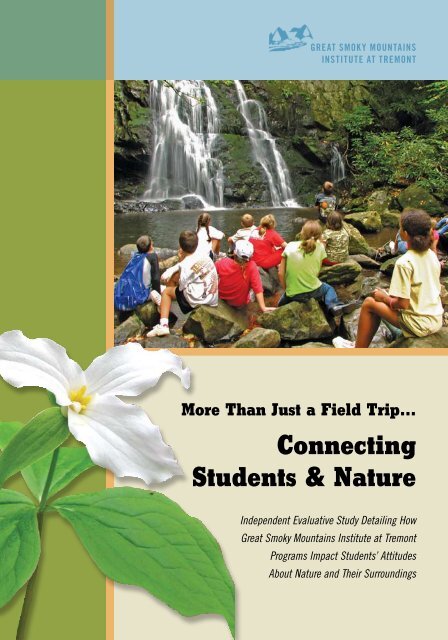
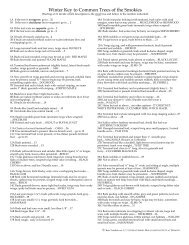

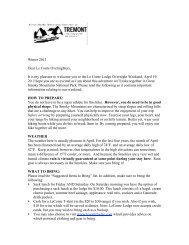
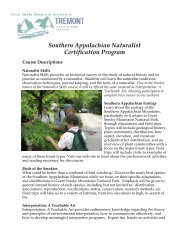

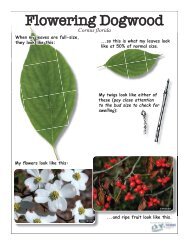
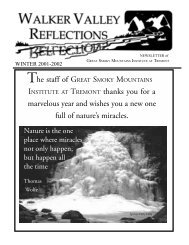
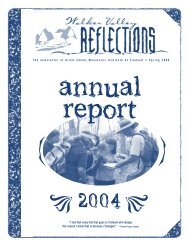
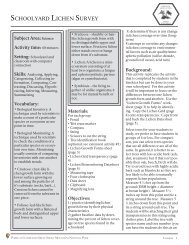
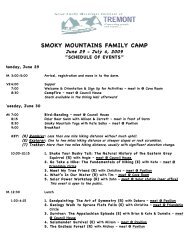
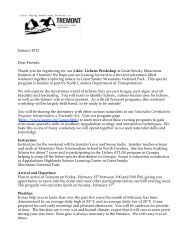
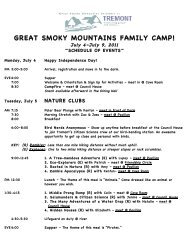
![Application [PDF] - Great Smoky Mountains Institute at Tremont](https://img.yumpu.com/22110613/1/190x245/application-pdf-great-smoky-mountains-institute-at-tremont.jpg?quality=85)
